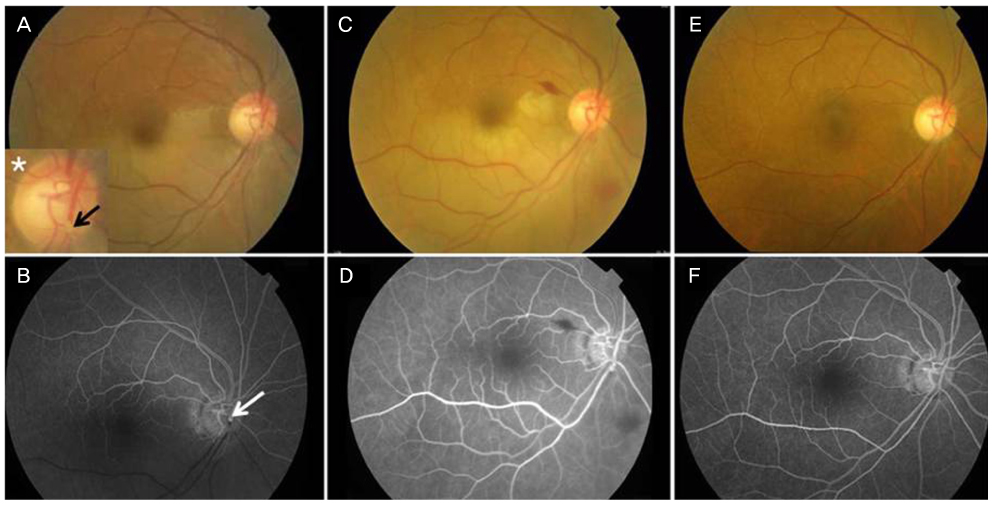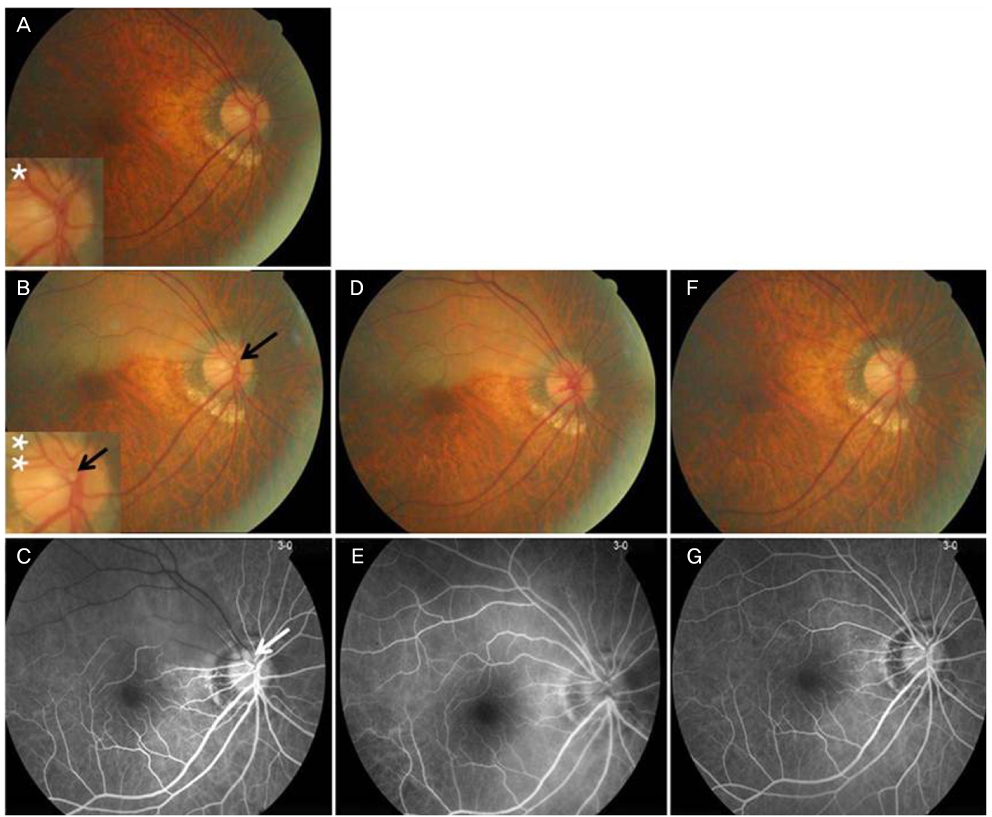Korean J Ophthalmol.
2009 Dec;23(4):315-317. 10.3341/kjo.2009.23.4.315.
Treatment of Branch Retinal Artery Occlusion With Transluminal Nd:YAG Laser Embolysis
- Affiliations
-
- 1Kong's Eye Clininc, Seoul, Korea.
- 2Department of Ophthalmology, Asan Medical Center, University of Ulsan College of Medicine, Seoul, Korea. Junekim@amc.seoul.kr
- KMID: 754772
- DOI: http://doi.org/10.3341/kjo.2009.23.4.315
Abstract
- The purpose of this paper was to report a successful treatment of transluminal Nd:YAG laser embolysis (NYE) for branch retinal artery occlusion (BRAO) with visible emboli. Two patients with acute, severe vision loss secondary to a branch retinal artery occlusion with visible emboli in one eye underwent NYE. A complete ocular examination was performed which included biomicroscopy of the posterior pole of the retina, intraocular pressure measurement, fundus color photographs, and fluorescein angiography (FA). After the NYE, the two patients showed dramatic improvements in best-corrected visual acuity, as well as, immediate and dramatic restorations in flow past the obstructed arteriole in FA. NYE is a treatment modality to be considered in patients with BRAO who present acutely with severe vision loss and a visible embolus.
MeSH Terms
Figure
Cited by 2 articles
-
Treatment of Acute Central Retinal Artery Occlusion with Ocular Ischemic Syndrome
Jong Hwan Lee, Ho Seok Moon, Dong Heun Nam, Dae Yeong Lee
J Korean Ophthalmol Soc. 2014;55(8):1242-1247. doi: 10.3341/jkos.2014.55.8.1242.A Case of Idiopathic Pediatric Acute Branch Retinal Artery Occlusion Involving the Macular Area
Ji Hye Jang, Jong Won Moon, Young Wook Cho
J Korean Ophthalmol Soc. 2014;55(2):304-308. doi: 10.3341/jkos.2014.55.2.304.
Reference
-
1. Brown GC, Shields JA. Cilioretinal arteries and retinal arterial occlusion. Arch Ophthalmol. 1979. 97:84–92.2. Ros MA, Larry ME, Uram M. Branch retinal-artery obstruction: a review of 201 eyes. Ann Ophthalmol. 1989. 21:103–107.3. Opremcak EM, Benner JD. Translumenal Nd:YAG laser embolysis for branch retinal artery occlusion. Retina. 2002. 22:213–216.4. Mason JO 3rd, Nixon PA, Albert MA Jr. Trans-luminal Nd:YAG laser embolysis for branch retinal artery occlusion. Retina. 2007. 27:573–577.5. Mason JO 3rd, Shah AA, Vail RS, et al. Branch retinal artery occlusion: visual prognosis. Am J Ophthalmol. 2008. 146:455–457.
- Full Text Links
- Actions
-
Cited
- CITED
-
- Close
- Share
- Similar articles
-
- An Electroretinographic Changes of Laser-induced Experimental Branch Retinal Vein Occlusion in the Rabbits
- Central Retinal Artery Occlusion Masquerading as Branch Retinal Artery Occlusion
- A Clinical Study of 36 Cases of Retinal Artery Occlusion
- Treatment of Acute Central Retinal Artery Occlusion with Ocular Ischemic Syndrome
- Retinal Arteriolar Changes in a Patient with Branch Retinal Vein Occlusion



